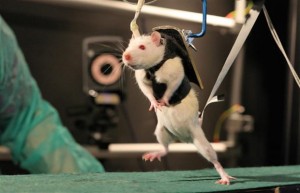New trials for treatment to help paralyzed walk ‘in a year’
- On July 31, 2012
- By JR Rehab
- In Industry News, News
 0
0

A previously paralyzed rat in a special harness walks voluntarily after several weeks of rehabilitation in a laboratory in Switzerland. In the new experiment reported in the Friday, June 1, 2012 issue of the journal Science, researchers led by Gregoire Courtine, of the University of Zurich and the technical university EPFL in Lausanne, Switzerland, stimulated spinal nerve circuits and used physical training. The stimulation was electrical current from implanted electrodes plus injections of a chemical mix, helping the rodents overcome paralysis to walk and climb stairs.
Photograph by: Ecole Polytechnique Federale de Lausanne, AP Photo
Paralyzed patients have been given new hope after scientists restored the ability to walk, run and even climb stairs to rats with severe spinal injuries.
Researchers witnessed “100 per cent recuperation” weeks after a treatment which forced the rodents to grow new nerve connections that bypassed their injuries.
A similar approach could be used on human patients with spinal injuries, with a clinical trial possible within one to two years, the scientists said.
It is the first study to demonstrate that a severely damaged spinal cord can adapt and recover sufficiently to allow the brain to regain control of the legs.
The researchers built on previous work in which chemicals and electrodes implanted in the spine below the site of the injury had been able to stimulate nerves, causing involuntary movement in rats’ legs.
In the new study they placed the rats in a harness to hold them upright, tricking their brains into thinking their spines were uninjured. They then put a piece of chocolate a short distance away.
Attempting to walk towards the treat encouraged their bodies to grow new nerve connections around the injured section of spine to the artificially aided nerves. Within two to three weeks the animals were able to walk on their hind legs while supported by the harness. Within five to six weeks they could run, climb stairs and move around obstacles while in the harness, a sure sign that their movement was now being controlled by their brains, the scientists said.
The team, from the Ecole Polytechnique Federale de Lausanne in Switzerland, said they were hopeful the same method could be applied to human patients with similar injuries and that the first clinical trials could begin soon.
Gregoire Courtine, lead author of the paper, published in the journal Science, said: “Our rats have become athletes when just weeks before they were completely paralyzed. I am talking about 100 per cent recuperation of voluntary movement.
“With this vertical support the rats are on their hind legs so the only way to walk forward is to force the brain to be active? . . . the brain develops a completely new way to orchestrate the movement [of the legs].”
Dr Elizabeth Bradbury, an expert in spinal injuries at King’s College London, said: “This is groundbreaking research and offers great hope for the future of restoring function to spinal injured patients. However, some questions remain before we know how useful this approach may be in humans.”
She said the “Holy Grail” was still to find a way to let the damaged spinal cord regrow in its entirety.
